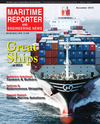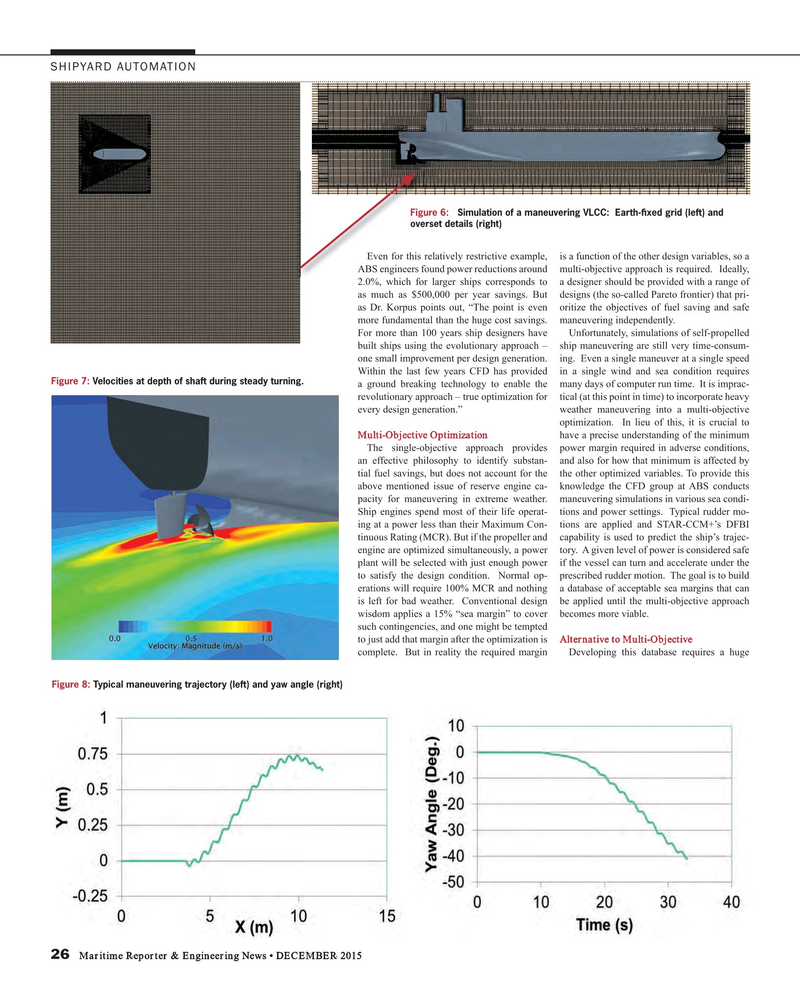
Page 26: of Maritime Reporter Magazine (December 2015)
Great Ships of 2015
Read this page in Pdf, Flash or Html5 edition of December 2015 Maritime Reporter Magazine
SHIPYARD AUTOMATION
Figu Figure 6: Simulation of a maneuvering VLCC: Earth-? xed grid (left) and ove overset details (right)
Even for this Even for this relatively restrictive example, is a function of the other design variables, so a
ABS engineers f ABS engineers found power reductions around multi-objective approach is required. Ideally, 2.0%, which for larger ships corresponds to a designer should be provided with a range of as much as $500,000 per year savings. But designs (the so-called Pareto frontier) that pri- as Dr. Korpus points out, “The point is even oritize the objectives of fuel saving and safe more fundamental than the huge cost savings. maneuvering independently.
For more than 100 years ship designers have Unfortunately, simulations of self-propelled built ships using the evolutionary approach – ship maneuvering are still very time-consum- one small improvement per design generation. ing. Even a single maneuver at a single speed
Within the last few years CFD has provided in a single wind and sea condition requires
Figure 7: Velocities at depth of shaft during steady turning.
a ground breaking technology to enable the many days of computer run time. It is imprac- revolutionary approach – true optimization for tical (at this point in time) to incorporate heavy every design generation.” weather maneuvering into a multi-objective optimization. In lieu of this, it is crucial to
Multi-Objective Optimization have a precise understanding of the minimum
The single-objective approach provides power margin required in adverse conditions, an effective philosophy to identify substan- and also for how that minimum is affected by tial fuel savings, but does not account for the the other optimized variables. To provide this above mentioned issue of reserve engine ca- knowledge the CFD group at ABS conducts pacity for maneuvering in extreme weather. maneuvering simulations in various sea condi-
Ship engines spend most of their life operat- tions and power settings. Typical rudder mo- ing at a power less than their Maximum Con- tions are applied and STAR-CCM+’s DFBI tinuous Rating (MCR). But if the propeller and capability is used to predict the ship’s trajec- engine are optimized simultaneously, a power tory. A given level of power is considered safe plant will be selected with just enough power if the vessel can turn and accelerate under the to satisfy the design condition. Normal op- prescribed rudder motion. The goal is to build erations will require 100% MCR and nothing a database of acceptable sea margins that can is left for bad weather. Conventional design be applied until the multi-objective approach wisdom applies a 15% “sea margin” to cover becomes more viable. such contingencies, and one might be tempted to just add that margin after the optimization is Alternative to Multi-Objective complete. But in reality the required margin Developing this database requires a huge
Figure 8: Typical maneuvering trajectory (left) and yaw angle (right) 26 Maritime Reporter & Engineering News • DECEMBER 2015
MR #12 (26-33).indd 26 MR #12 (26-33).indd 26 12/4/2015 12:05:45 PM12/4/2015 12:05:45 PM

 25
25

 27
27
